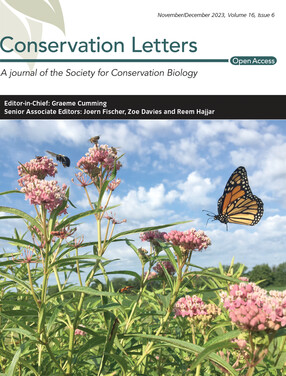拓宽包容性保护的理由:与自然对人类贡献相关的价值观
IF 7.7
1区 环境科学与生态学
Q1 BIODIVERSITY CONSERVATION
引用次数: 0
摘要
忽视与“自然对人类的贡献”(NCP)相关的各种价值观会破坏保护工作。为了检验这种尚未充分研究的关联,我们将NCP和多元价值框架结合起来,研究价值观如何与具有共同NCP偏好的人群(称为NCP偏好集群)相关联。在坦桑尼亚乞力马扎罗山由国家公园和人类居住和耕地组成的社会生态系统(SES)内,对362名农民、50名自然保护工作者、55名导游和156名游客进行了623次调查。我们确定了五个不同的集群,每个集群都表达了不同程度的内在、工具和关系价值。虽然每个框架都忽略了人与自然关系的关键方面,但将这两个框架结合起来可以更好地把握这种关系的多维性,并为包容性保护提供关键见解。为了认识到NCP偏好与不同价值之间的独特关联,在不损害生物多样性和生态系统功能的前提下,在具有保护区的SESs中采用多样化的基于地点的保护方法是至关重要的。本文章由计算机程序翻译,如有差异,请以英文原文为准。
Broadening the Justifications for Inclusive Conservation: Values Associated With Nature's Contributions to People
Overlooking the diverse values associated with Nature's Contributions to People (NCP) undermines conservation efforts. To examine this underresearched association, we combined the NCP and plural valuation frameworks to investigate how values are associated with groups of people with shared NCP preferences, referred to as NCP preference clusters. We conducted 623 surveys with 362 farmers, 50 nature conservationists, 55 tour guides, and 156 tourists within the social–ecological system (SES) of Mount Kilimanjaro, Tanzania, comprising a national park as well as inhabited and cultivated areas. We identified five distinct clusters, each expressing varying degrees of intrinsic, instrumental, and relational values. While each framework overlooks key dimensions of people–nature relationships, combining both frameworks better captures the multidimensionality of such relationships and provides pivotal insights for inclusive conservation. To recognize the distinct associations between NCP preferences and diverse values, diversifying place‐based conservation approaches in SESs with (a) protected area(s), without compromising biodiversity and ecosystem functioning, is pivotal.
求助全文
通过发布文献求助,成功后即可免费获取论文全文。
去求助
来源期刊

Conservation Letters
BIODIVERSITY CONSERVATION-
CiteScore
13.50
自引率
2.40%
发文量
70
审稿时长
>12 weeks
期刊介绍:
Conservation Letters is a reputable scientific journal that is devoted to the publication of both empirical and theoretical research that has important implications for the conservation of biological diversity. The journal warmly invites submissions from various disciplines within the biological and social sciences, with a particular interest in interdisciplinary work. The primary aim is to advance both pragmatic conservation objectives and scientific knowledge. Manuscripts are subject to a rapid communication schedule, therefore they should address current and relevant topics. Research articles should effectively communicate the significance of their findings in relation to conservation policy and practice.
 求助内容:
求助内容: 应助结果提醒方式:
应助结果提醒方式:


